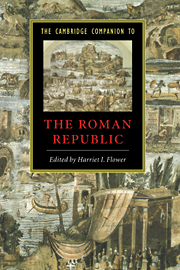Book contents
- Frontmatter
- Introduction
- PART 1 POLITICAL AND MILITARY HISTORY
- PART 2 ROMAN SOCIETY
- 5 Under Roman Roofs: Family, House, and Household
- 6 Women in the Roman Republic
- 7 The Republican Economy and Roman Law: Regulation, Promotion, or Reflection?
- 8 Roman Religion
- PART 3 ROME'S EMPIRE
- PART 4 ROMAN CULTURE
- PART 5 EPILOGUE: THE INFLUENCE OF THE ROMAN REPUBLIC
- Timeline
- Bibliography
- Index
8 - Roman Religion
from PART 2 - ROMAN SOCIETY
Published online by Cambridge University Press: 28 May 2006
- Frontmatter
- Introduction
- PART 1 POLITICAL AND MILITARY HISTORY
- PART 2 ROMAN SOCIETY
- 5 Under Roman Roofs: Family, House, and Household
- 6 Women in the Roman Republic
- 7 The Republican Economy and Roman Law: Regulation, Promotion, or Reflection?
- 8 Roman Religion
- PART 3 ROME'S EMPIRE
- PART 4 ROMAN CULTURE
- PART 5 EPILOGUE: THE INFLUENCE OF THE ROMAN REPUBLIC
- Timeline
- Bibliography
- Index
Summary
Roman religion neither existed as a discrete cultural practice in its own right nor could it be found hidden beneath other cultural practices. It was only in the very late Republic that there were attempts to coin cumulative descriptions like sacra et auspicia (Cic. Nat. D. 3.5), meaning 'cults and divination', yet it is only Cicero who uses religio as a generic term encompassing a group's duty towards, and care of, the gods. Cicero's religio, however, encompasses neither the organizational infrastructure and degree of coherence of these activities, nor their shared symbolic language, nor any related metaphysical reflection. To talk about Roman religion, therefore, is to talk about a range of cultural practices conforming to our notion of religion; this notion has, to be sure, grown out of Roman thought and terminology, but it has been strongly influenced by Christian discourse and the eighteenth-century Enlightenment.
It is no improvement to substitute the plural 'religions' for the singular 'religion'.1 This use of 'religions', which is fashionable at the moment, goes even further in suggesting the existence of a plurality of self-contained and neatly separated religious traditions or systems, on the model of early modern Christian denominations. By contrast, this chapter aims to demonstrate both the internal pluralism and the characteristic lack of clear external borders in Roman religious practices within their ancient Mediterranean context.
- Type
- Chapter
- Information
- The Cambridge Companion to the Roman Republic , pp. 179 - 196Publisher: Cambridge University PressPrint publication year: 2004
- 2
- Cited by

